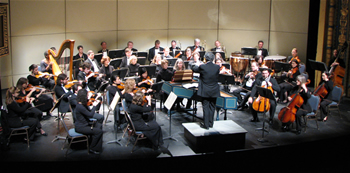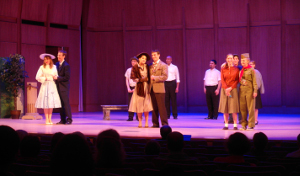The Carolina Theatre in Durham, given a $1.8 million renovation over the summer, hosted the Chamber Orchestra of the Triangle in their performance of “The Classical Style” on Sunday afternoon. Lorenzo Muti, conductor and artistic director, kicked off the orchestra’s 29th season with performances of Michael Haydn’s Symphony in E-Flat, Wolfgang Amadeus Mozart’s Symphony No. 39 in E-Flat, K.543, and Ludwig van Beethoven’s Symphony No. 7 in A, Op. 92. The performance was very intimate, with Muti giving short program notes before the first piece, more or less explaining to the audience why he’d chosen these three pieces for the orchestra’s first concert of the season. The orchestra is off to an energetic start, as could be seen by the quality of this first performance.
The Haydn symphony is one that exemplifies the beginnings of the orchestral symphony, as Muti explained; Michael Haydn, the younger brother of the popular Franz Joseph Haydn (who was known as the “father of the symphony”), was a contemporary of Wolfgang Amadeus Mozart’s father Leopold. Michael Haydn wrote his Symphony in E-Flat in the traditional form and used the tonality and thematic elements that would later inspire Mozart the younger’s Symphony No. 39, making the two an excellent pair for the first half of the program. The orchestra, slightly reduced in size for the first symphony, played the Haydn crisply and very much according to the Classical style, with just the proper athleticism necessary in the flying passages of the third movement.
The second symphony involved a small change of orchestration, with the flutes and clarinets trading places with the oboes as well as the addition of the timpani. There were obvious style differences in the two composers, including in the second work played much more use of the woodwinds in their own featured sections, increased thematic material and development, and more variation in dynamics and colors. In some passages the string sections seemed to push the envelope and increase the passion of the piece; this occasionally introduced intonation issues because of overplaying but for the most part added to the heightening of the energy that Mozart intended us to hear.
As a closer, Beethoven’s Symphony No. 7 could not have been a better choice. This piece called for the full orchestra, with full brass and woodwind parts showcased especially in the third movement. Muti’s conducting reflected the passion of the piece, and not only in the beat patterns – sometimes he literally jerked his arms up and down or back and forth, but he definitely got the point across. Beethoven’s symphony takes the idea of the genre a step further, changing keys, time signatures, and tonalities frequently and toying with audience expectations. The Chamber Orchestra hit the nail on the head here, pausing for suspense, emphasizing unusual key changes, and reveling in Beethoven’s quirks. The second movement, a famous Allegretto that has a somber, processional feel, was a total contrast to the rest of the symphony, remaining so without Muti overdoing dynamics or tempos: it was just what Beethoven wrote.
Overall the concert was historically and technically very faithful to the original writing of the symphonies. An aspect that is likely to be overlooked is the fact that Lorenzo Muti did not conduct with a baton throughout the concert, but used only his body, a technique that would have been used in the late 1700s when the three symphonies were written. This was a nice and insightful touch. However, it was difficult for Muti to make his entrances and exits from the stage because it was so cramped; although the symphonies called for a large group, this seemed an odd problem after the massive renovations of the hall and made the beginning of the concert a little awkward.
Beethoven’s Symphony No. 7 is relatively popular but not too often performed here; the other two symphonies are very rare. This kickoff concert provided an excellent opportunity to hear “exceptional music, including rarely performed works,” as is listed as a goal in the Chamber Orchestra of the Triangle’s mission statement. Based upon the interpretation and care that went into this concert, equally well-planned and well-performed music can be expected from the orchestra in the coming season.
The COT’s season continues on November 13. For details, see our calendar.
Note: We welcome Andrea L. McKerlie to the pages of CVNC. She is majoring in flute at Meredith College and is one of our 2011-12 interns. For more information, click here.












